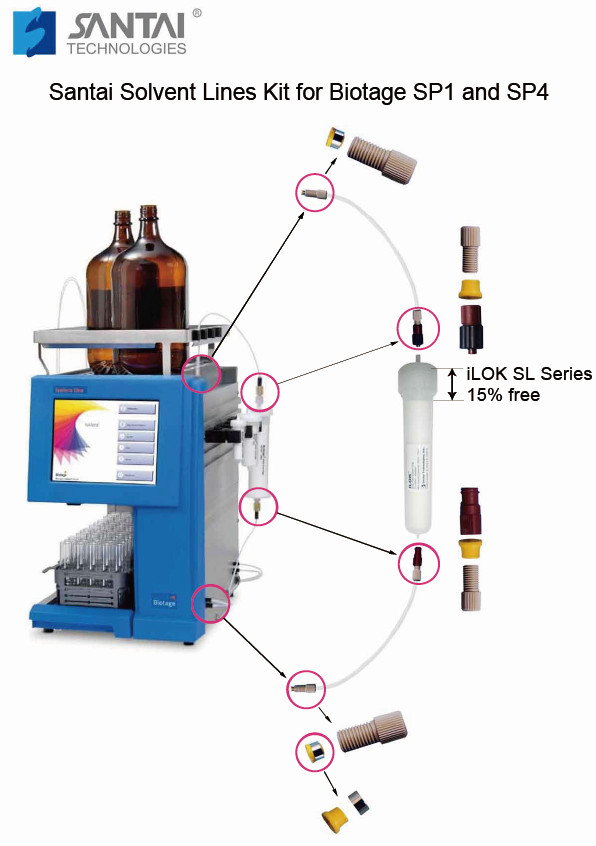-
How to connect empty iLOK columns on Biotage system?
-
Does functionalized silica dissolve in water?
No, end-capped silica is insoluble in any commonly used organic solvent.
-
What are the points of attention for using C18 flash columns?
For optimal purification with C18 flash columns, please follow these steps:
① Flush the column with 100% of the strong (organic) solvent for 10 – 20 CVs (column volume), typically methanol or acetonitrile.
② Flush the column with 50% strong + 50% aqueous (if additives are required, include them) for another 3 – 5 CVs.
③ Flush the column with the initial gradient conditions for 3 – 5 CVs. -
What’s the connector for large flash columns?
For column size between 4g and 330g, standard Luer connector is used in these flash columns. For column size of 800g, 1600g and 3000g, additional connector adaptors should be used to mount these large flash columns on the flash chromatography system. Please refer to the document Santai Adaptor Kit for 800g, 1600g, 3kg Flash Columns for more details.
-
Whether the silica cartridge can be eluted by methanol or not?
For normal phase column, it is recommended to use the mobile phase where the ratio of methanol does not exceed 25%.
-
What is the limit for using polar solvents like DMSO, DMF?
Generally, it is recommended to use the mobile phase where the ratio of the polar solvents does not exceed 5%. The polar solvents include DMSO, DMF, THF, TEA etc.
-
Solutions for solid sample loading?
Solid sample loading is a useful technique to load the sample to be purified onto a column, particularly for samples of low-solubility. In this case, iLOK flash cartridge is a very suitable choice.
Generally, the sample is dissolved in a suitable solvent and adsorbed onto a solid adsorbant which could be the same as used in flash columns, including diatomaceous earths or silica or other materials. After removal / evaporation of the residual solvent, the adsorbent is put on top of a partly filled column or into an empty solid loading cartridge. For more detailed information, please refer to the document iLOK-SL Cartridge User guide for more details. -
What is the test method of column volume for the flash column?
Column volume is approximately equal to dead volume (VM) when ignoring the additional volume in the tubings connecting the column with the injector and the detector.
Dead time (tM) is the time required for elution of an unretained component.
Dead volume (VM) is the volume of the mobile phase required for elution of an unretained component. Dead volume can be calculated by the following equation:VM =F0*tM.
Among the above equation, F0 is the flow rate of the mobile phase.
-
Does functionalized silica dissolve in methanol or any of the other standard organic solvents?
No, end-capped silica is insoluble in any commonly used organic solvent.
-
Whether the silica flash cartridge can be used repeatedly or not?
The silica flash columns are disposable and for single use, but with proper handling, the silica cartridges can be reused without sacrificing performance.
In order to be reused, the silica flash column needs to be simply dried by compressed air or flushed with and stored in isopropanol. -
What are the suitable preservation conditions for C18 flash cartridge?
Proper storage will allow C18 flash columns to be reused:
• Never allow the column to dry out after using.
• Remove all organic modifiers by flushing the column with 80% methanol or acetonitrile in water for 3 – 5 CVs.
• Store the column in the above mentioned flushing solvent with end fittings in place. -
Questions about thermal effect in the pre-equilibrium process for flash columns?
For the large size columns above 220g, the thermal effect is obvious in the process of pre-equilibrium. It is recommended to set the flow rate at 50-60% of the suggested flow rate in pre-equilibrium process to avoid obvious thermal effect.
The thermal effect of mixed solvent is more obvious than single solvent. Take the solvent system cyclohexane/ethyl acetate as an example, it is suggested that use 100% cyclohexane in the pre-equilibrium process. When pre-equilibration is completed, the separation experiment could be performed according to the preset solvent system.


